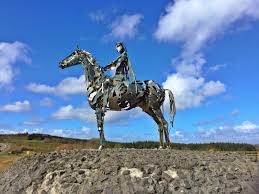The last Gaelic lords of Ireland never gave up hope of a restoration of their power and lands

Now, 400 years after the collapse of the Gaelic world, their lives and legacy are being remembered and restored in a way that no one could have anticipated.
It has taken us centuries to counter the destructive force of English colonialism in Ireland (and the work is by no means complete) but there are unmistakable signs that the effort is truly underway at last.
Ireland was sacked, exploited, and impoverished for centuries after the Earls, our last line of defense were stripped of their inheritances and driven from their homeland.
Considering how remarkable their stories are, it’s a surprise that we haven’t done much more to commemorate the Earls of Ulster. Take Red Hugh O’Donnell for example. For most of his life, he lived in a pitched battle for his land and future.
Imprisoned in Dublin Castle as a teenager, he made a daring escape that eventually led him into battle against the entire Tudor expansion in Ireland.
O’Donnell was proclaimed Chieftain at the rock of Doon at Kilmacrennan in County Donegal in 1592, becoming the leader of Tyrconnell (modern-day Donegal).
Later his clan fought alongside their allies the Maguires and the O’Neills in an Irish confederacy that conducted the remarkably successful Nine Years War against the English. Many people don’t realize just how close they came to ending English sovereignty in Ireland.
So when their fortunes finally did change and they were driven abroad, Red Hugh traveled to Spain in the hope of winning more military support from Philip III. It was not forthcoming however and he died there at the early age of 29.
Meanwhile in Rome Hugh O’Neill, the Earl of Tyrone, likewise hoped for a restoration of his lands and title, having fled Ireland during the famous Flight of the Earls. He died in Rome in 1616, the same year William Shakespeare passed away, which shows you how close in time we still are to them.

Hugh O’Neill, the Earl of Tyrone, in an engraving by William Hall
After so many military successes the abrupt changes in their fortune must have been heartbreaking. O’Neill had once defeated Queen Elizabeth’s generals in Ulster, effortlessly outmaneuvering the Earl of Essex, who led the biggest English army Ireland had ever seen to suppress his island-wide revolt.
Did they know they were standing at the end of a centuries-long story, these Earls? Did they have the abiding sense of an ending?
They were the last of the Mohicans, these men, the last living links to an unbroken Irish tradition that stretched back over a millennia. Deeply rooted in their land and culture, they were among the last truly whole examples of a Gaelic man.
Wouldn’t you want to take a good look at one of them if you could? Wouldn’t you want to speak to them in English and their native Irish if you had a chance? Well, increasingly you may be able to.

San Pietro in Montorio Church, the resting place of the last High King of Ireland, Hugh O’Neill.
O’Neill is buried in the Church of San Pietro in Montorio in Rome, which was built by Ferdinand and Isabella of Spain on an elevated position that catches the evening breezes and looks out over the city’s fabled hills. Visitors are welcome each day. The Irish arrive nonstop to it.
Meanwhile, in Spain, we are now closer than we have come in hundreds of years to the last days of Red Hugh’s fateful journey and possibly to Red Hugh himself.
Naturally, the news is making headlines around the world. The current search was inspired by Donegal man Brendan Rohan who visited the city of Valladolid in search of the grave, and who’s not taking no for an answer enthusiasm eventually resulted in the ongoing major archaeological dig (never doubt that one man can make a difference).
A group of O’Donnell’s descendants has already been lined up for genetic testing if they do indeed find Red Hugh’s remains during the excavation. That will bring him closer to us than he has been in centuries. Even the search is bringing him closer to us.
And here’s why this matters. These men were at the center of our history, their story is ours.
If you visit the little church of San Pietro in Rome now be prepared to meet a slow but steady stream of Irish visitors and scholars arriving morning, afternoon and evening. Because Ireland remembers, and the north remembers.
The inspirational stories of The O’Donnell and The O’Neill have not been lost, nor has their language or legacy.
In fact, in recent decades, their tale is being increasingly reassembled, reassessed and re-valued by scholars, historians and the general public. What once seemed broken beyond repair is springing back to life. We are taking ownership of our past, not reeling from it.

Rathmullan Priory, built in 1508, plundered by Geroge Bingham 1595 and later used as a barracks
Rathmullan, the Donegal town from which the Earls set sail, has a commemorative sculpture of their sad departure, but the actual place that local lore says they boarded a ship from is a private lawn in private hands.
You might think that the site of the most significant change in Irish history would be better marked, or marked at all, but to this day Rathmullan is the home-place of both Gael and Planter, and that contested history might be better put to rest now finally with a public celebration of both.
Across the lough from Rathmullan is the Inishowen peninsula, where the last living Gaelic lord, my own namesake, was driven into revolt against the crown in 1608. He was shot in Kilmacrennan, the same town-land where Red Hugh has become chieftain years earlier.
O’Doherty’s Keep is the name of one of his families properties, a fifteenth-century historic structure that is currently being restored in an inspirational new project to tell the tale of Gaelic Ireland, the Nine Years War, the Flight of the Earls and the start of the Plantation, whilst reclaiming the living history and salvaging a little of what was lost. You can learn more about this project and support it by clicking here.
Putting the roof back on the sacked keep of the last Gaelic Lord of Ireland is a simple but profoundly symbolic act of reclamation and restoration. It may be one of the most important cultural benchmarks of our own progress as a people in generations.
After four centuries the restoration of the keep, which will be open to the public to tell a history that was overshadowed and lost, will also bring light back into a place where for centuries the shadows have ruled.
From O’Donnell to O’Neill, from Spain to Italy, these stories are finally coming full circle and in O’Doherty’s Keep, built near the lough where they last looked at Ireland, they will soon be welcomed home at last. It’s time.



Post a comment